|
AH-64D Apache Longbow
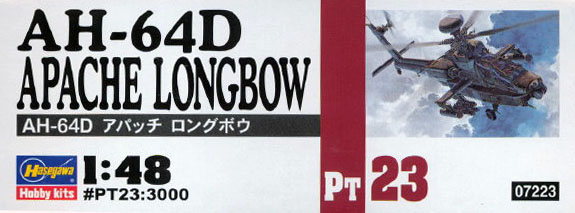
Hasegawa
S
u m m a r y
|
| Catalogue Number
and Description: |
PT23 - AH-64D Apache Longbow |
| Scale: |
1/48 |
| Price: |
3000 Yen |
| Review Type: |
First Look |
| Advantages: |
Generally excellent detail; most
accurate AH-64D kit |
| Disadvantages: |
Some minor nitpick criticisms; Seats
could be better |
| Recommendation: |
Recommended |

HyperScale is proudly supported by Squadron
Reviewed by Dave
Williams
General Overview
The kit has fine recessed panel lines with raised rivet detail (the real
Apache is covered in raised rivets). The overall level of detail is high and the
molding quality is very good. Some minor flash, which is a little surprising for
a new-tool Hasegawa kit. The kit has clear seekers for the Hellfire missiles and
numerous small detail parts. All of the AH-64D specific parts are one on sprue,
which will undoubtedly be simply swapped out for the AH-64A release recently
announced by Hasegawa. Note that only a “D” model is possible from this kit as
you only get the enlarged sponsons, the instrument panels with the
multi-function display (MFD) screens, and do not get the tall air data sensor
mast that goes above the main rotor.
Details
Cockpit
Nicely detailed and, finally, an accurate “D” model cockpit with
the proper MFDs. Hasagawa has molded the co-pilot gunner’s (CPG) cyclic stick in
the folded position instead of just copying the pilot’s stick. The CPG’s helmet
position sensors are even included, but Hasegawa omitted the corresponding ones
for the pilot. Weakest parts of the cockpit are the seats, which lack cushion
texture and only include the shoulder straps, omitting the lap and crotch
straps. Two pilot clones are included for those who like little men.
Click the thumbnails below to view
larger images:
Rotors
The rotor head and blades are nicely detailed and the blade pitch change
mechanisms are made up of numerous individual small parts instead of being
molded all together. Polycaps are installed in the base of the rotors to allow
these assemblies to be installed after painting. One item I would like to have
seen Hasegawa do differently is to not have molded the large rectangular blocks
at the blade root as part of the main rotor head. Because they are at right
angles to the mold, they are not as detailed as they could have been if they
were separate parts.
Landing Gear
The main tires come pre-flattened. The tailwheel is, unfortunately, split and
molded as part of the tailwheel strut halves.
Click the thumbnails below to view
larger images:
 Weapons Weapons
Standard loadout of two rocket pods and eight Hellfire missiles. The Hellfire
missiles have separate noses to allow different versions to be built. One nose
type is tapered with a small seeker (radar?) and the other is constant diameter
with a larger hemispherical laser seeker. There is also a third nose of constant
diameter and slightly longer than the other nose, bit it is listed as not for
use in this boxing (click the thumbnail to the
right). You get eight of each type of nose, so you can mix and
match as you like. The Chain Gun is also well done.
Engines
Unlike other kits, the exhausts are separate from the engine
nacelles, which might make filling the inevitable seam that runs across the end
of the exhausts a little easier.
 Strangely,
Hasegawa molded the two doors in the underside of the nacelle in the closed
position . These seem to be always
open on the ground when the engines aren’t running in photos I have seen and
other 1/48 Apache kits have these doors open (although they are usually way too
thick). Strangely,
Hasegawa molded the two doors in the underside of the nacelle in the closed
position . These seem to be always
open on the ground when the engines aren’t running in photos I have seen and
other 1/48 Apache kits have these doors open (although they are usually way too
thick).
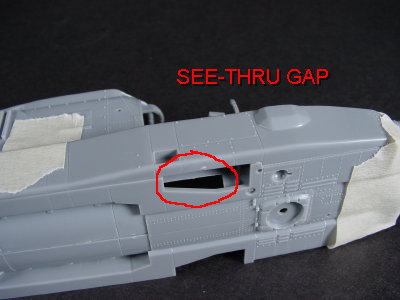 Fuselage Fuselage
There are numerous holes that must be opened up from the inside before the
fuselage halves are glued together, so study the instructions carefully.
The fit of the sponsons and underside plate is generally quite good, however
the cutout in the bottom of the fuselage is shaped for the “A” model underside
plate and the “D” plate does not completely fill the cutout.
Although not a problem when the model is viewed from the top or side, if the
model is turned over, one can look up through the wheel wells and into the
fuselage to see the bottom of the cockpit tub. Some simple sheet plastic will
help with this problem.
The sponsons are the production models with the cooling vents at the rear.
Clear parts
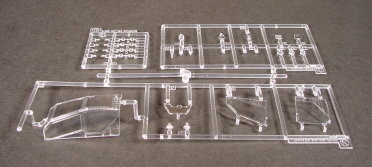 The
canopy is designed to be shown in the open position. Removing and cleaning up
some of the very small lights may be a challenge. The
canopy is designed to be shown in the open position. Removing and cleaning up
some of the very small lights may be a challenge.
My canopy has a narrow, faint line (a small molding flaw?) running across the
middle top pane, which appears to be in, not on, the plastic. It isn’t a scratch
with depth and isn’t very noticeable, but it is there.
Possibly a dip in Future will hide it.
Other details
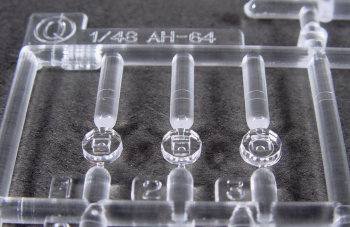 Numerous
small parts in the form of antennas, grab handles, and clear navigation lights. Numerous
small parts in the form of antennas, grab handles, and clear navigation lights.
The underfuselage doppler radar fairing is a separate part which avoids
having a hard-to-fill seam running through the fairing. The Fire Control Radar (FCR)
dome is well detailed and the parts sprue contains an unused part (D7) which
appears to be a cap that goes on top of the rotor head when the radar is not
installed.
The two boxes that go on the side of the mast directly below the FCR as
molded open on the side facing the dome and should probably be filled in.
Although not mentioned in the instructions, the IR jammer (disco light) is
included if one wants to add it. The light is on the clear sprue and consists of
three faceted discs (Q1,2,3) which are stacked to form the jammer (see image
above).
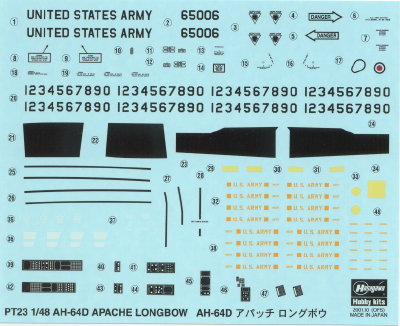 Decals Decals
These are the standard thick Hasegawa decals, which might be more of a
problem on this kit as many have to go down on areas which have a lot of rivet
detail.
A fair amount of stencil decals are included and there are markings for each
Hellfire missile, although they are for the inert carry rounds. Markings given
for serial number 96-5006, but generic numbers are also included.
Optional decals for the part of the instrument panels and the side consoles.
|
Home | What's
New | Features
| Gallery |
Reviews | Reference
| Forum
| Search